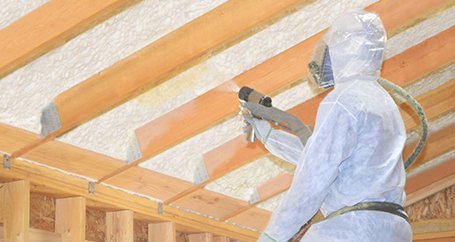An important decision that can go overlooked during the construction process of your new home is the type of insulation to be used throughout the structure. Not doing your homework on the different types of insulators can have costly repercussions throughout the life of your new home. Historically, fiberglass insulation was the standard material used when insulating a residential home, but recent trends show a shift in the market toward spray-foam. Spray foam is widely recognized by builders as the superior option to traditional fiberglass and here’s why.
Spray Foam has the ability to expand once applied to the area. Standard spray foam consists of two chemicals, polyurethane and isocyanate, commonly found in various materials likely around your house already (mattress and furniture foam). When the compounds are sprayed out of a spray foam gun they expand as soon as they leave the hose. This affords it the ability to completely cover the area in need of insulating. It fills every nook and cranny drastically reducing the airflow when compared to its distant cousin fiberglass. Spray foams expanding capabilities allow it to save somewhere around 30% in annual energy costs potentially saving the homeowner thousands over the products lifespan.
Another huge benefit of spray foam is the life of the product. The measure of how well a product can restrict the flow of air is the resistance value or R-value. The R- value of fiberglass is 2.2 per inch when it’s brand new and will deteriorate over time with an expected life span of about 10-25 years if it remains dry. On the other hand, spray foam has an initial R – value of 3.5 and maintains that high level of performance for upwards of 80 years. Although foam must be applied by a professional if it needs to be replaced or repaired, there is a slim chance it will take place in your lifetime due to normal wear and tear.
Unlike fiberglass insulation, foam is also impervious to mold and bacteria. One of the worst nightmares to a homeowner is mold appearing anywhere in their house. The open cell foam compound popularly used for residential insulation does absorb some moisture, but spray foam provides no nutritional value to mold or bacteria. If there is nothing for the mold to feed on, then it won’t be able to grow or spread. Pair that with its superior ability to prevent moist outside air from penetrating the sealed barrier mentioned earlier in this article and you have a solid first line defense from harmful bacteria.
The major negative attribute of spray foam is the initial cost. Fiberglass generally costs about $0.40 per square foot and can be installed by anyone. Spray foam generally costs around $0.80 to cover the same area and must be applied by a professional due to some minor health risks when in wet form. After about a 12-hour curing process where the foam is allowed to harden it becomes safe to touch with no harmful gasses emanating from it.
Spray foam is quite literally a product that will pay for itself over a few short years by cutting down on energy costs and providing a smaller workload for the air conditioning unit. We highly recommend it in every home we build.

